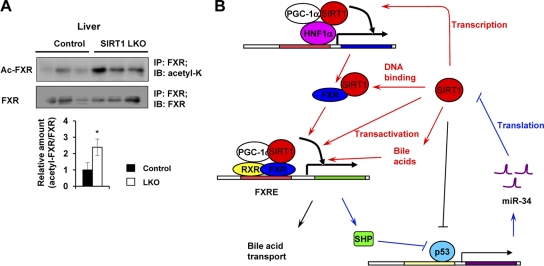Fig 8.
SIRT1 regulates FXR signaling at multiple levels. (A) Acetyl-FXR levels are significantly elevated in SIRT1 LKO mice. Total liver extracts from control and SIRT1 LKO mice were immunoprecipitated with goat anti-FXR antibodies and then immunoblotted with rabbit anti-acetyl-K antibodies or mouse anti-FXR antibodies (n = 3). *, P < 0.05. (B) The interaction network between SIRT1 and the FXR signaling pathway. SIRT1 modulates the activity of FXR signaling at multiple levels (red lines). First, SIRT1 regulates the expression of FXR through interaction with HNF1α, which may also involve coactivator PGC-1α. Second, SIRT1 deacetylates FXR, increasing its DNA binding affinity. Third, SIRT1 deacetylates PGC-1α, thereby activating the transactivation activity of FXR. Finally, SIRT1 stimulates the biosynthesis of bile acids, which in turn bind to FXR and induce its transcriptional activity. FXR, on the other hand, increases the translation of SIRT1 protein via SHP-mediated inhibition of p53 transactivation and thereby miR34a expression (blue lines). This positive feedback network plays an essential role in the regulation of bile acid metabolism. Alterations of these loops in the SIRT1 LKO mice lead to impairments in bile acid synthesis and transport, resulting in development of cholesterol gallstones.

